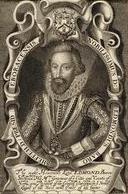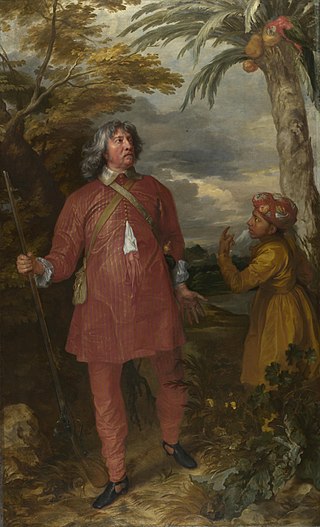Related Research Articles

Duke of York is a title of nobility in the Peerage of the United Kingdom. Since the 15th century, it has, when granted, usually been given to the second son of English monarchs. The equivalent title in the Scottish peerage was Duke of Albany. However, King George II and King George III granted the titles Duke of York and Albany.

Marquess of Normanby is a title that has been created twice, once in the Peerage of England and once in the Peerage of the United Kingdom. The first creation came in 1694 in the Peerage of England in favour of John Sheffield, 3rd Earl of Mulgrave. He was a notable Tory politician of the late Stuart period, who served under Queen Anne as Lord Privy Seal and Lord President of the Council. In 1703 this first Marquess of Normanby was further honoured when he was made Duke of Buckingham and Normanby. These titles became extinct on the death of the 2nd Duke in 1735.

Duke of Cambridge is a hereditary title of nobility in the British royal family, one of several royal dukedoms in the United Kingdom. The title is named after the city of Cambridge in England. It is heritable by male descendants by primogeniture, and has been conferred upon various members of the British royal family several times throughout history.

The House of Stuart, originally spelled Stewart, was a royal house of Scotland, England, Ireland and later Great Britain. The family name comes from the office of High Steward of Scotland, which had been held by the family progenitor Walter fitz Alan. The name Stewart and variations had become established as a family name by the time of his grandson Walter Stewart. The first monarch of the Stewart line was Robert II, whose male-line descendants were kings and queens in Scotland from 1371, and of England, Ireland and Great Britain from 1603, until 1714. Mary, Queen of Scots, was brought up in France where she adopted the French spelling of the name Stuart.

Duke of Albany is a peerage title that has occasionally been bestowed on younger sons in the Scottish and later the British royal family, particularly in the Houses of Stuart and Hanover.

Duke of Buccleuch, formerly also spelt Duke of Buccleugh, is a title in the Peerage of Scotland created twice on 20 April 1663, first for James Scott, 1st Duke of Monmouth, and second suo jure for his wife Anne Scott, 4th Countess of Buccleuch. Monmouth, the eldest illegitimate son of King Charles II, was attainted after rebelling against his uncle King James II and VII, but his wife's title was unaffected and passed on to their descendants, who have successively borne the surnames Scott, Montagu-Scott, Montagu Douglas Scott and Scott again. In 1810, the 3rd Duke of Buccleuch inherited the Dukedom of Queensberry, also in the Peerage of Scotland, thus separating that title from the Marquessate of Queensberry.

Duke of Richmond is a title in the Peerage of England that has been created four times in British history. It has been held by members of the royal Tudor and Stuart families.

Earl of Rothes is a title in the Peerage of Scotland. It was created in 1458 for George Leslie, 1st Lord Leslie. He had already been created Lord Leslie in 1445, also in the Peerage of Scotland. His grandson, the third Earl, having only succeeded his elder brother in March 1513, was killed at the Battle of Flodden on 9 September of the same year. His son, the fourth Earl, served as an Extraordinary Lord of Session. Lord Rothes was also tried for the murder of Cardinal Beaton but was acquitted.
Earl of March is a title that has been created several times, respectively, in the Peerage of Scotland and the Peerage of England. The title derives from the "marches" or borderlands between England and either Wales or Scotland, and it was held by several great feudal families which owned lands in those districts. Later, however, the title came to be granted as an honorary dignity, and ceased to carry any associated power in the marches.

The title Earl of Mulgrave has been created twice. The first time as a title in the Peerage of England and the second time as a Peerage of the United Kingdom.

Duke of Berwick(Spanish: Duque de Berwick) is a title that was created in the Peerage of England on 19 March 1687 for James FitzJames, the illegitimate son of James II and VII, King of England, Scotland, and Ireland and Arabella Churchill. The title's name refers to the town of Berwick-upon-Tweed in England, near the border with Scotland.
The title of Earl of Cambridge was created several times in the Peerage of England, and since 1362 the title has been closely associated with the Royal family.

William Feilding, 1st Earl of Denbigh was an English courtier and peer who served as the Custos Rotulorum of Warwickshire from 1628 to 1643. As the brother-in-law of George Villiers, 1st Duke of Buckingham, the royal favourite of James VI and I, he became involved in several major events during the Stuart period.

Charles Stewart, 3rd Duke of Richmond KG was an English peer who was the fourth cousin of Charles II of England, being both descended in the male line from John Stewart, 3rd Earl of Lennox.
Henry Waldegrave, 1st Baron Waldegrave was an English peer and Jacobite supporter.

Clan Stewart is a Scottish Highland and Lowland clan. The clan is recognised by Court of the Lord Lyon; however, it does not have a clan chief recognised by the Lord Lyon King of Arms. Because the clan has no chief it can be considered an armigerous clan; however, the Earls of Galloway are now considered to be the principal branch of this clan, and the crest and motto of The Earls of Galloway's arms are used in the Clan Stewart crest badge. The Court of the Lord Lyon recognises two other Stewart/Stuart clans, Clan Stuart of Bute and Clan Stewart of Appin. Stuart of Bute is the only one of the three clans at present which has a recognised chief.

James Stuart, Duke of Cambridge KG was the second son of the Duke of York and his first wife, Anne Hyde. In 1664, the infant James became the first Duke of Cambridge and Baron of Dauntsey, titles his uncle, King Charles II, created especially for him. The King also appointed Cambridge a Knight of the Garter, but never invested him due to his untimely death. Cambridge received a yearly pension of £3,000 from the king.
Edgar Stuart, Duke of Cambridge was the fourth son of James, Duke of York and his first wife Anne Hyde. He was second in the line of succession to the English and Scottish thrones.
Baron Caryll of Durford (or Dunford) of Harting in West Sussex is a title in the Jacobite Peerage of England created by the dethroned King James II for John Caryll, poet, dramatist and diplomat, with apparently a special remainder to the issue male of his brothers.
Henrietta Butler, Viscountess Galmoye, previously Henrietta Waldegrave, Baroness Waldegrave, was an illegitimate daughter of James Stuart, Duke of York, subsequently King of England, Scotland and Ireland, by his mistress, Arabella Churchill. Upon marrying, she became Lady Waldegrave, and then with her second marriage Viscountess Galmoye, as well as Countess of Newcastle.
References
- Sir Nicholas Harris Nicolas; William John Courthope (1857). The Historic Peerage of England: Exhibiting, Under Alphabetical Arrangement, the Origin, Descent, and Present State of Every Title of Peerage which Has Existed in this Country Since the Conquest; Being a New Edition of the "Synopsis of the Peerage of England". John Murray. pp. 89–90.